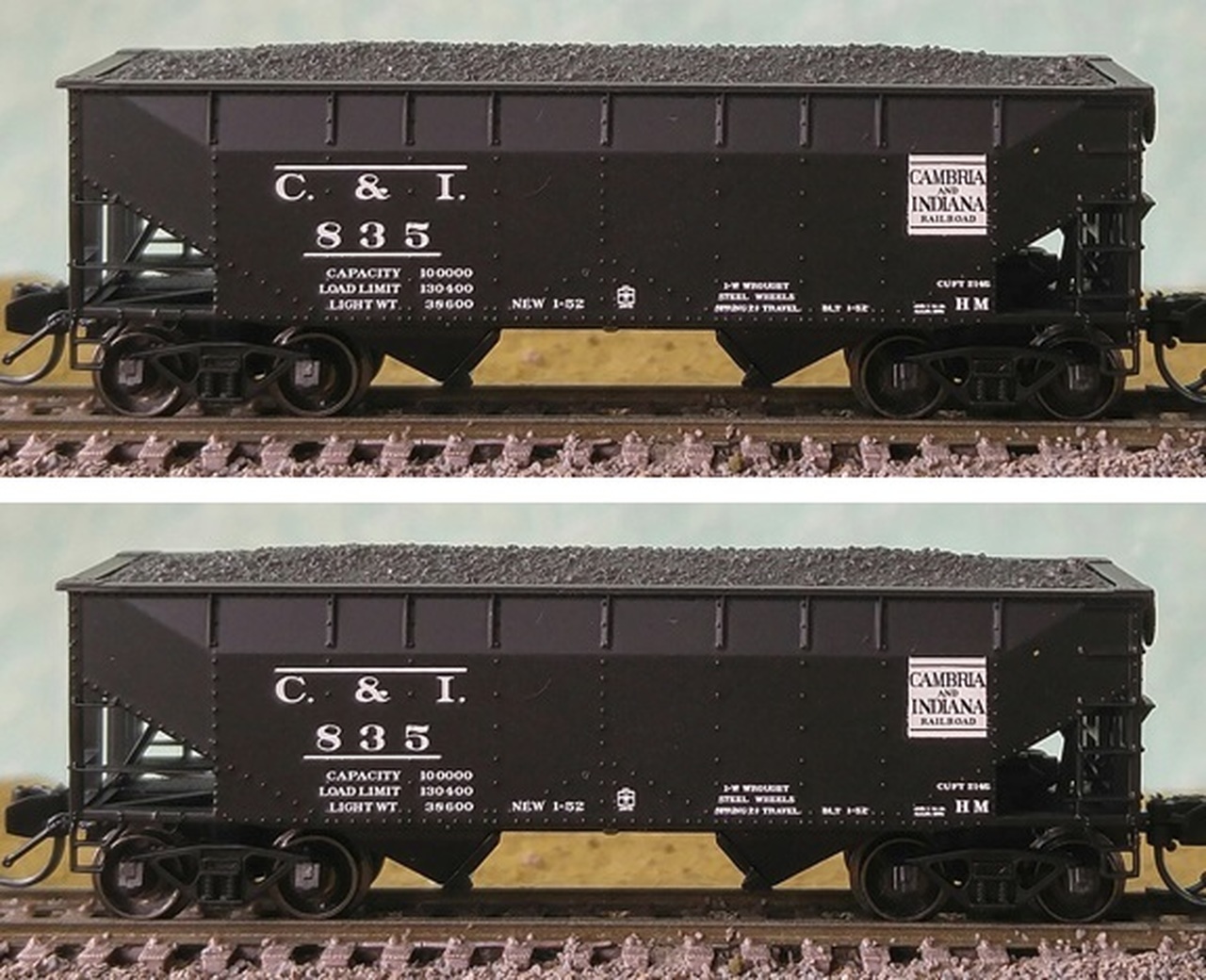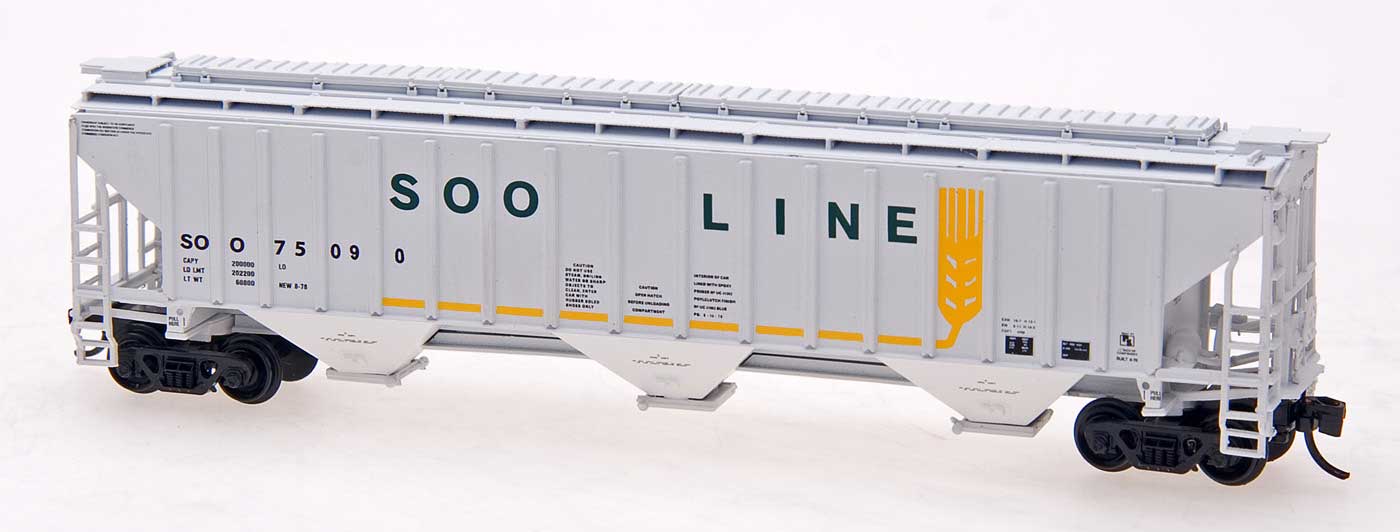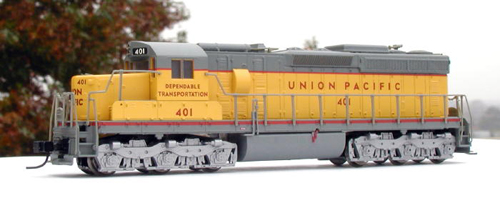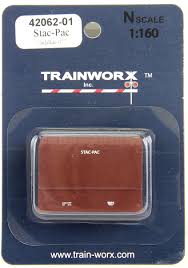Model Information: Bluford Shops is proud to announce our fourth new body style in N scale for July 2017. Our new 2-Bay Offset Side hopper features a die cast slope sheet-hopper bay-center sill assembly; injection molded plastic sides, ends and hopper doors; fully molded brake tank, valve and air lines; body mounted brake hose detail; load; body mounted magnetically operating knuckle couplers; and Fox Valley Models metal wheel. Each road name will be available in multiple road numbers. MSRP is $24.95 per car.
A 2-bay hopper design with offset sides was first proposed in the 1920s and first appeared in the form seen here in 1934. The AAR adopted it as a standard design the following year. The offset design permitted greater interior capacity than a rib side car with the same outside dimensions. It was thought this more than made up for the car’s higher cost of construction. The last new 2-bay offset side hoppers were built in 1960.
All road names are available in multiple road numbers. For instance, order a single, a 2-pack and a 3-pack to get all six road numbers on a run. (Some road names will be available in just three road numbers.)
A 2-bay hopper design with offset sides was first proposed in the 1920s and first appeared in the form seen here in 1934. The AAR adopted it as a standard design the following year. The offset design permitted greater interior capacity than a rib side car with the same outside dimensions. It was thought this more than made up for the car’s higher cost of construction. The last new 2-bay offset side hoppers were built in 1960.
All road names are available in multiple road numbers. For instance, order a single, a 2-pack and a 3-pack to get all six road numbers on a run. (Some road names will be available in just three road numbers.)
Prototype History: The late 1920s saw the introduction of the AAR standard “offset-side” 50- and 70-ton hoppers. The design went through several variations in the late 1920s and early 1930s before settling on two versions of the 50-ton car and one 3-bay, 70-ton car in 1935. Most roads went for the AAR standard designs, but the N&W, VGN, and Pennsy were notable holdouts. World War II brought the famous “war emergency” hoppers (only the N&W and MP bought the 70-ton version) and several composite versions of existing designs. After the war, AC&F found some brief success with a welded outside-stake hopper design, but the weld joints broke under the stress of loading and unloading rather than flexing like riveted joints. The offset-side design also had problems: the inside stakes were more prone to corrosion, and they suffered worse from loading and unloading stress than outside-staked hoppers. The design waned in the 1950s and was all but abandoned for new cars by 1960. Some roads (notably the C&O, the B&O, and the L&N) made the best of a bad situation by rebuilding their offset-side cars with all new outside-staked sides in the late 1950s and early 1960s.
Road Name History: 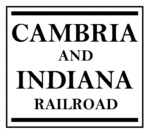 The Cambria & Indiana was born in 1911 with the renaming of the Blacklick & Yellow Creek Railroad. The line ran in its namesake counties in Pennsylvania. Built as a lumber hauler, coal quickly took over as the primary commodity. In the 1930s and 40s, the C&I was the richest railroad per mile of track in the country but when oil and gas became more popular for home heating, some of this traffic disappeared. C&I had always owned many more hoppers than they could possibly load on their own line. This large fleet was rented to other railroads to load where needed. In 1950, the railroad was sold to Bethlehem Steel who could then keep their own freight car production lines busy between orders building hoppers for the C&I. Those hoppers could then be rented out. In 1963, Bethlehem Steel opened a new coal mine on the line which fed considerable traffic to the C&I for the next 31 years. The closure of this last mine on the C&I led to the closure of the railroad in 1994. Like the Conemaugh & Black Lick, C&I eventually adopted the yellow and black paint scheme used for all of Bethlehem Steel's shortlines.
The Cambria & Indiana was born in 1911 with the renaming of the Blacklick & Yellow Creek Railroad. The line ran in its namesake counties in Pennsylvania. Built as a lumber hauler, coal quickly took over as the primary commodity. In the 1930s and 40s, the C&I was the richest railroad per mile of track in the country but when oil and gas became more popular for home heating, some of this traffic disappeared. C&I had always owned many more hoppers than they could possibly load on their own line. This large fleet was rented to other railroads to load where needed. In 1950, the railroad was sold to Bethlehem Steel who could then keep their own freight car production lines busy between orders building hoppers for the C&I. Those hoppers could then be rented out. In 1963, Bethlehem Steel opened a new coal mine on the line which fed considerable traffic to the C&I for the next 31 years. The closure of this last mine on the C&I led to the closure of the railroad in 1994. Like the Conemaugh & Black Lick, C&I eventually adopted the yellow and black paint scheme used for all of Bethlehem Steel's shortlines.

Brand/Importer Information: Bluford Shops began in 2007 as a side project of two model railroad industry veterans, Craig Ross and Steve Rodgers. They saw a gap between road names available on N scale locomotives but not available on cabooses. They commissioned special runs of Atlas cabooses in Atlantic Coast Line, Central of Georgia, Monon, Boston & Maine and Southern plus runs on Grand Trunk Western and Central Vermont on the MDC wooden cabooses. While these were in process, they began to develop their first all new tooling project, 86' Auto Parts Boxcars in double door and quad door editions in N scale. By January of 2008, Bluford Shops became a full time venture. Along with additional N scale freight cars and their own tooling for new cabooses, they have brought their own caboose line to HO scale. They also have their popular Cornfields in both HO and N. The future looks bright as they continue to develop new products for your railroad.
The town of Bluford in southern Illinois featured a small yard on Illinois Central's Edgewood Cutoff (currently part of CN.) The yard included a roundhouse, concrete coaling tower (which still stands) and large ice house. Reefer trains running between the Gulf Coast and Chicago were re-iced in Bluford. Things are more quiet now in Bluford with the remaining tracks in the yard used to stage hoppers for mines to the south and store covered hoppers. Intersecting the IC line in Bluford is Southern Railway's (currently NS) line between Louisville and St. Louis. Traffic on this single track line remains relatively heavy.
The town of Bluford in southern Illinois featured a small yard on Illinois Central's Edgewood Cutoff (currently part of CN.) The yard included a roundhouse, concrete coaling tower (which still stands) and large ice house. Reefer trains running between the Gulf Coast and Chicago were re-iced in Bluford. Things are more quiet now in Bluford with the remaining tracks in the yard used to stage hoppers for mines to the south and store covered hoppers. Intersecting the IC line in Bluford is Southern Railway's (currently NS) line between Louisville and St. Louis. Traffic on this single track line remains relatively heavy.
Item created by: Jenna on 2018-07-13 16:20:59
If you see errors or missing data in this entry, please feel free to log in and edit it. Anyone with a Gmail account can log in instantly.
If you see errors or missing data in this entry, please feel free to log in and edit it. Anyone with a Gmail account can log in instantly.


